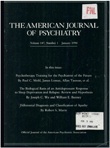Electroretinograms in autism: a pilot study of b-wave amplitudes
Abstract
The authors recorded electroretinograms for 27 autistic patients and 20 age- and sex-matched healthy volunteers. Thirteen (48%) of the autistic patients demonstrated subnormal b-wave amplitudes, which may indicate abnormal retinal function. One patient was tested serially at two sites; his low b-wave amplitude did not vary over time or between the two sites. If this retinal finding can be confirmed at other laboratories and in larger samples of autistic patients, it might provide a marker for a specific subtype of autism.
Access content
To read the fulltext, please use one of the options below to sign in or purchase access.- Personal login
- Institutional Login
- Sign in via OpenAthens
- Register for access
-
Please login/register if you wish to pair your device and check access availability.
Not a subscriber?
PsychiatryOnline subscription options offer access to the DSM-5 library, books, journals, CME, and patient resources. This all-in-one virtual library provides psychiatrists and mental health professionals with key resources for diagnosis, treatment, research, and professional development.
Need more help? PsychiatryOnline Customer Service may be reached by emailing [email protected] or by calling 800-368-5777 (in the U.S.) or 703-907-7322 (outside the U.S.).



